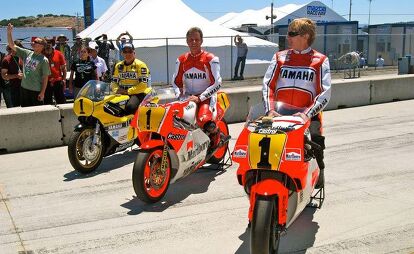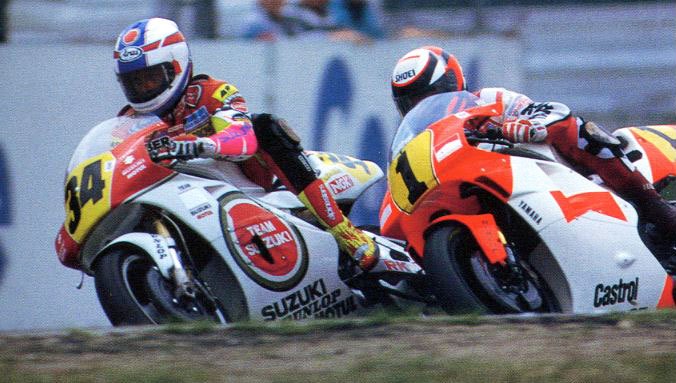Tomfoolery - From Domination To Near Extinction
I hate being the nihilistic voice of MO, but when it comes to the state of American talent at world-level motorcycle road racing, we’re f*#ked. If the swirling rumors of Nicky Hayden’s departure from MotoGP come to pass, it’ll be the first time since 1977 America’s been absent from competing at the world’s highest level of two-wheel racing. Truly sad – especially considering the U.S. hosts two MotoGP rounds.
Sure, I’m a Vale Rossi fan who’d love to see the old man reclaim his former glory in a last hurrah this season. But that doesn’t mean I’m not into supporting my fellow compatriot at his home rounds in Texas and Indy. Nicky’s not in contention for the championship, so there’s no reason I can’t cheer the guy in the middle of the pack as much as the guy at the front of the pack.
The real issue, though, isn’t the departure of Hayden from MotoGP, it’s the vacuum of American talent, the Mr. Nobody alternate, there to take his place. There’s scuttlebutt about Hayden maybe moving to World Superbike, which would make him the only American competing in that series. If, for some reason, a WSBK ride doesn’t materialize and Hayden retires from MotoGP, we’d be left with no Americans in either world-level series.
I don’t particularly care for pop country music. There’s no stars and stripes streaming from the back of my Japanese pick-up truck. You won’t find me espousing the unfounded virtues of American exceptionalism. But let’s put into perspective the role of American racers competing in both MotoGP/500cc and World Supers.
American MotoGP/500cc World Champions | |||
|---|---|---|---|
| Season | Category | Rider | Constructor |
| 2006 | MotoGP | Nicky Hayden | Honda |
| 2000 | 500cc | Kenny Roberts Jr | Suzuki |
| 1993 | 500cc | Kevin Schwantz | Suzuki |
| 1992 | 500cc | Wayne Rainey | Yamaha |
| 1991 | 500cc | Wayne Rainey | Yamaha |
| 1990 | 500cc | Wayne Rainey | Yamaha |
| 1989 | 500cc | Eddie Lawson | Honda |
| 1988 | 500cc | Eddie Lawson | Yamaha |
| 1986 | 500cc | Eddie Lawson | Yamaha |
| 1985 | 500cc | Freddie Spencer | Honda |
| 1984 | 500cc | Eddie Lawson | Yamaha |
| 1983 | 500cc | Freddie Spencer | Honda |
| 1980 | 500cc | Kenny Roberts | Yamaha |
| 1979 | 500cc | Kenny Roberts | Yamaha |
| 1978 | 500cc | Kenny Roberts | Yamaha |
Our Grand Prix golden age was the years spanning from 1978 – when “King” Kenny Roberts began the American domination of 500cc Grand Prix motorcycle racing – to Kevin Schwantz’s title in 1993. Thirteen championships out of 16 seasons. Kenny Roberts Jr. followed in his dad’s footsteps with a championship title in 2000. Six years later Hayden made his cameo appearance in the hall of champions, but there hasn’t been an American since, and there doesn’t appear to be one on the horizon.
We’re no better off in the World Superbike series. This year’s demise of Larry Pegram’s Team Hero EBR squad was a double whammy that left the WSBK paddock devoid of both American racer and American motorcycle. An emigration for Hayden from MotoGP to WSBK would, at least, keep America represented in a world series, but we’d be hanging by thread.
When WSBK launched in 1988, America’s motorcycle racing talent pool was spilling over. We won five championships out of the first six seasons; 1988 to 1993, while concurrently winning 500cc Grand Prix championships.
American World Superbike Champions2009Ben SpiesYamahaWhat happened? Did America squander its motorcycle road racing talent like watering a Las Vegas golf course? Blame it on the Great Recession, DMG’s hostaging of American Superbike racing, Justin Bieber, the removal of artificial colors and flavors from breakfast cereals, I don’t know, blame it on something or nothing. What I do know is we gotta get our motorcycle racing mojo back. Hopefully, three-time 500cc Grand Prix World Champion, Wayne Rainey and his crew at MotoAmerica can resolve the problem and set a course for a second coming of American racing talent.
Which is exactly what Rainey and KTM are doing with the KTM RC Cup. From an interview Troy Siahaan conducted with Rainey earlier this year, Rainey says “One of the other things we’re doing this year that we’re really excited about is that we have this KTM RC390 Cup. It’s a spec cup for amateur racers. It’s the first time, I believe, that in the AMA championship at least, that we’ve been able to have an amateur series involved with a national championship, so it gives the teams a chance to look at the talent coming through. Everybody’s on a spec bike, they’re reasonably priced, and also it gives them the experience to be racing at a national championship.
“If there’s one thing we were maybe lacking before,” Rainey continued, “it was giving youngsters a chance to get there [Europe] sooner. We didn’t have that. This is a great idea that KTM came up with, and at the end of the day, the winner gets to go on to Europe and race. So, I think it’s an awesome thing. I’ve said this before: if I was 14 years old, I’d have five or six paper routes, I’d be having my mom and dad do whatever it took to do this. This is going to be great for our series.”
Rainey has been a longtime advocate of motorcycle road racing in America. He was influential in MotoGP’s return to Laguna Seca in 2005, and now he’s holding the reigns to MotoAmerica. If he applies the same determination to making MotoAmerica successful and developing a youthful talent pool as he did to his own racing career (which you have to assume he will), it bodes well that America could regain its lofty position on the world stage of motorcycle road racing.
Wayne Rainey To Be Honored At AMA Ceremony
Let’s also give some much-deserved credit to KTM, for without its RC Cup there’d be no national venue dedicated to grooming the next generation of American road racers. From KTM’s RC Cup Race Guide:
“KTM understands the importance of catering to future riders of bigger displacement models by stimulating the market with smaller displacement sportbikes. With this in mind, the company is ecstatic to be partnering with MotoAmerica for the 2015 KTM RC Cup; allowing the next generation of racers to attack America’s most renowned circuits on the new KTM RC 390 Cup Race Bike.” Amen to that, KTM!
The irony here is that KTM is still largely recognized in the U.S. as a dirtbike company. With the roadracing recognition of the RC Cup in the MotoAmerica series, the Super Duke R earning Bike of the Year honors from us, as well as other publications, KTM’s persona is quickly changing.
Hopefully, the efforts of Rainey, KTM and all the unsung heroes of U.S. motorcycle road racing will save the American MotoGP/WSBK champion from extinction. It’s probably going to take a while because, from a world perspective, stock in American roadracing has fallen far, but I’m faithful it’ll rebound. In the meantime, I’m hoping Hayden and Rossi can keep competing for a couple more seasons. No offense to Lorenzo, Marquez, et al., but let’s face it, they’re neither American nor are they Rossi.
A former Motorcycle.com staffer who has gone on to greener pastures, Tom Roderick still can't get the motorcycle bug out of his system. And honestly, we still miss having him around. Tom is now a regular freelance writer and tester for Motorcycle.com when his schedule allows, and his experience, riding ability, writing talent, and quick wit are still a joy to have – even if we don't get to experience it as much as we used to.
More by Tom Roderick











































Comments
Join the conversation
OK, I will make this easy BUT I want your comment.
0. Kick ass fun, small venue, fast pace and the observer can see themselves as a contestant.
1. The phone with apps is most enthralling to the young and provides an instant (sickness) reward. It is stealing young brains away from real speed-dreams. Apps into this racing will get the young hooked into the real race life. Participant and/or competitor.
2. What ever the race type... sponsors must see a way to sell, promote, market and align user groups. From run what you brung to Formula.
4. This idea calls for something akin to a figure 8 with a bridge in the middle with tons of viewing stands and camera angles. 1 mile to two miles length, can go to any fairground or also any large race track. Right and left turns and straights through the center tunnel.
5. Run it as if a twisted multi-lap, long distance drag race, 4 to 7 laps, main 10 to 12.
5. The viewing stands are nearly in the pits. There are no bad seats.
Immerse the public and the support will follow. Everybody in Europe is a motorcyclist.
So, immerse the phone nut and get on with the racing.
This is an outline for an idea to which added turns and straights vary the venue. Comments?
We need to get back to the basics. What do all those riders have in common? Dirt track. We need to get back to grass roots racing. Support your local dirt track. The bikes are not as specialized as they used to be. You can go out and get a stock 450 and with a little bit of modification make a short tracker.